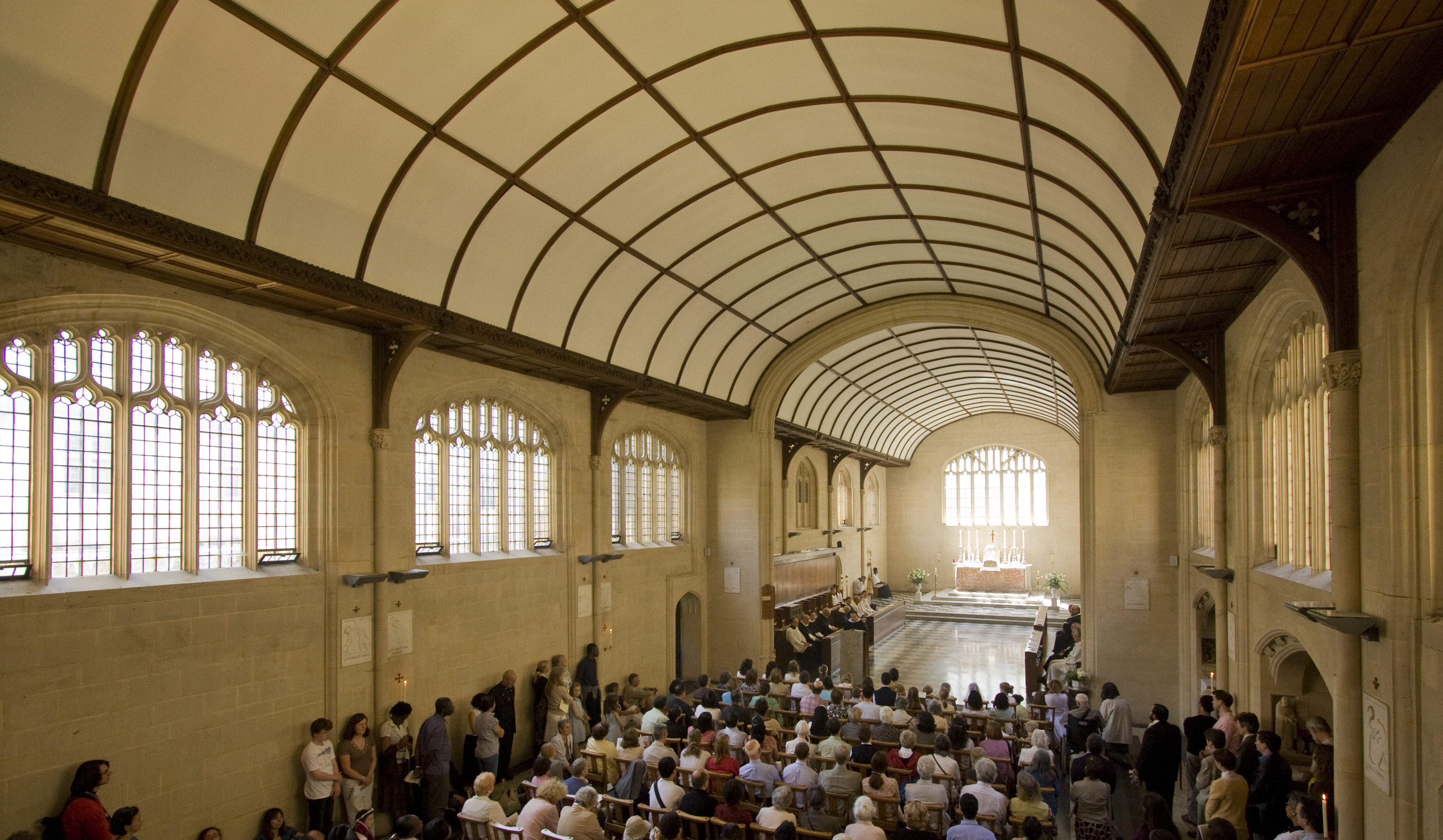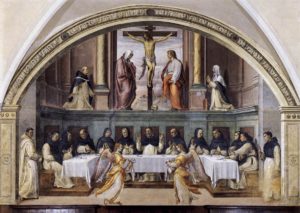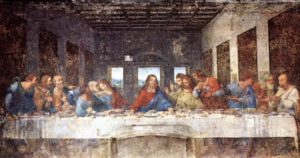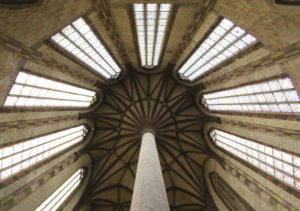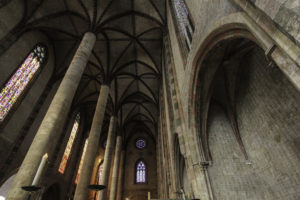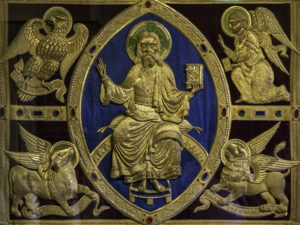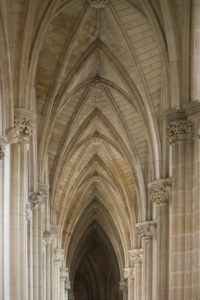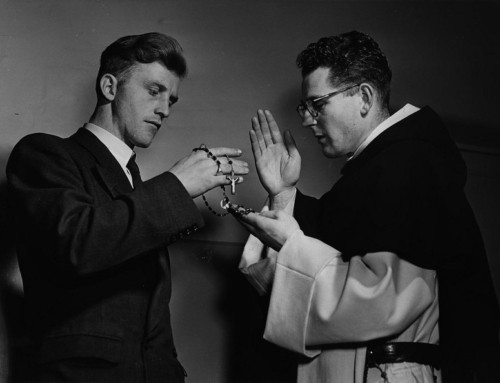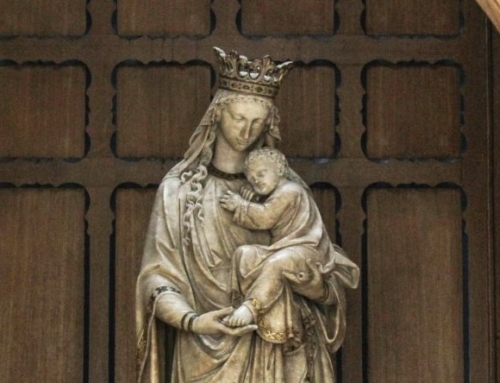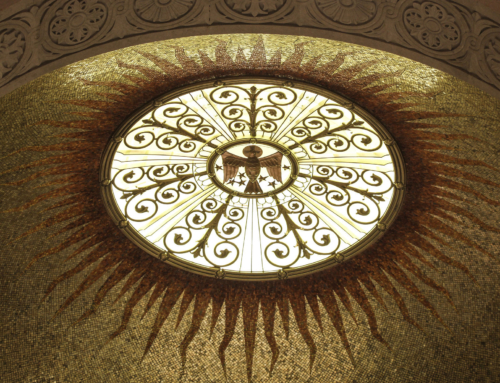How lovely is thy dwelling place,
O Lord of Hosts!— Psalm 84
The Dominican priory is an outgrowth of the Dominican form of life, but the two share a reciprocal relationship: Dominican life is meant to be lived in a Dominican priory. The architecture finds its form by incorporating the many functions of the life of contemplation and preaching. Just as a friar must learn how to balance the demands of his vowed life, so too the priory’s design must balance the functional requirements for the friar’s form of life. The friar must learn how to grow in charity amidst the requirements of study, prayer, communal life, and apostolic life. The priory provides the setting for the friar’s schooling in charity, and in so doing, it facilitates or detracts from that schooling. The habit does not make the friar, and neither does the priory. However, this does not mean that neither the habit nor the priory is inconsequential. Just as the habit serves as an external sign of the interior reality of the friar’s consecration to God, so too does the priory serve as a sign communicating the reality of a consecrated life. The priory signifies the life lived within it, and it is at the service of that life.
The life of the friar requires balance and ordering because there are many demands placed upon him in the life. The friar finds this order by following after the example of St. Dominic, who, it is said, only spoke to God or about God. Having a well-ordered soul, the saintly friar moves easily between prayer, silence, recreation, study, worship, preaching, administrative tasks, and eating. This is evidenced by the example of Bl. Henry Suso, O.P., who would pray to Eternal Wisdom before his meals, “Most sweet Jesus Christ, I invite Thee with the longing desire of my heart, and I pray Thee, even as Thou dost bountifully feed me, to grant me also today Thy gentle presence.”
The fresco in the refectory of the San Marco priory by Giovanni Antonio Sogliani, St. Dominic and his Friars fed by Angels [fig. 1], mirrors The Last Supper by Leonardo DaVinci [fig. 2], which was painted for the Dominican refectory in Milan. Bl. Henry’s prayer and the frescos of Sogliani and DaVinci show the harmony between the friar’s interior life and the priory. In addition to art, there are more architectural considerations which seek harmony. I would like to propose three conspicuous considerations in the design of a Dominican priory. Their peculiarity stems from tensions integral to the life of contemplation and action of a Dominican. We will consider silence, poverty, and preaching.
Silence
The Dominican priory imposes a distinct challenge to the architect to design a secluded monastery within the busy confines of a city. St. Dominic desired his sons to live a contemplative life amidst the locale of an apostolic life. The priory must be a silent vessel for the interior life of the friar, while the world scratches at its walls. The anxiety of the world, and its cries for truth, impinge on the friar’s silence. Monks pray in secluded monasteries on mountain tops, and priests run bustling parishes from city rectories. However, the Dominican friar lives his contemplative life in a priory and goes out from that priory to meet the needs of the Church.
The Constitutions of the Order of Preachers emphasize the influence that silence has on religious observance: “Silence is the guardian of all observance and contributes greatly to the interior quality of religious life, to peace, prayer, the study of truth and authenticity in preaching.” A friar achieves silence by an intentional recollection of God’s presence amongst various activities. Yet this intentionality can be supported or hindered by the surrounding environments. There is silence of soul and silence of ambiance. One is more easily recollected in the silent wilderness than on Bourbon Street during Mardi Gras.
It is for this reason that St. Anthony fled the city to find a desert cave. His actions echo those of our Lord’s, “he withdrew to the wilderness and prayed” (Lk 5:16). Following St. Anthony’s example, monks soon cultivated the wilderness with monasteries. Forested mountains and marshy fields became places of prayer away from urban centers. Yet, St. Dominic saw the need for contemplative preachers, and he therefore envisioned a place of prayer within the city, the priory.
One solution to the juxtaposition of the Dominican friar and the urban laity was the tramezzo. This Italian word, which translates “through the middle,” names an architectural feature used to separate the choir of the monks from the laity, commonly known as a rood screen (the Saxon word “rood” means “cross”). However, the pre-Tridentine tramezzo carried more weight and art than we typically understand of the rood screen. The tramezzo still standing at the Albi Cathedral dwarfs the rood screen here at our House of Studies in Washington, D.C. Similar dividing walls of more humble stature used to stand in the Dominican priories of Florence.
The tramezzo did not serve as a security fence, but as a good divider. On the Dominican side of the wall, it served as a buffer for distractions and wandering eyes. On the laity side, the tramezzo served as a devotional canvas. It was common for the laity to actually adorn the tramezzo with images of Our Lady or other saints. Also, according to the research of Marcia Hall, “One of the purposes of the raised stage of the tramezzo was, after all, to proclaim the Gospel, because it was the only place in the church from which both the clergy and the laity could be addressed at the same time” (Sacred Architecture Vol. 27, p.15). The division actually served to emphasize the preaching and proclamation of the Gospel. At the reading of the Gospel, the laity and the religious are united.
Outside of the chapel, there are other key design decisions which impact how much silence the friar can find within the priory. Whereas the tramezzo aides silence within the chapel, strategic placement of rooms can also help silence the noise of ministry within the priory. Typically the friar’s cell is one of the most silent places within the priory, and the common room, where the friars recreate together, has the most noise. It would be detrimental for the interior life to place a friar’s cell next to the common room or a common room next to a chapel. Even the best sound attenuation cannot stifle the roar of a Dominican recreation. This is why cells generally are on the top floor of the priories and more public or noisy spaces tend to be on the ground level.
Another way to ensure silence within the priory is to control the path of the visitor and the friar so that they do not cross. This does not mean that they never meet within the priory, but there is an importance to having a cloister and a semi-cloister. That is why the Constitutions of the Order read, “Cloister is to be observed in our convents so that our brothers may be better able to devote themselves to contemplation and study, that more intimate family life may be achieved, and the faithfulness and characteristics of our religious life may be revealed.”
A visitor travelling through the building should notice what is public and private. Simply passing through a door communicates to the visitor that a transition is happening. Also, it should be possible for the friar to travel from his choir stall to his cell without exiting the cloister. There are old accounts of the brethren processing up a stairwell after Night Prayer into their dormitories in silence.
Separation seems to be the architectural solution to navigate the tension of desired silence and apostolic life. This is why the Acta from 1249 read, “Screens which in our churches are between the laity and the friars are to be so disposed there by the priors so that on entering and exiting from the choir the friars cannot see nor be seen by the laity. They can also establish here some windows so that at the time of the elevation of the body of the Lord they [i.e., the laity] might be able to look in.”
The beautiful walls traversing the nave of the chapel provide needed screening, but also serve the devotion of the laity. Also, the savvy arrangement of rooms creates an ordering of silence throughout the whole priory. Finally, the cloister creates areas of strict separation and loose mingling. Separation is a key concept when designing around the tension of the contemplative and active life.
Poverty
The tension of poverty emerges in a different and more precarious way than the tension of silence. The tension of silence in the midst of activity results from the pull of contemplation and ministry which are both intrinsic to living the life. The tension of poverty stems from the desire for poverty of spirit and the attraction of the world. Therefore, the tension of poverty does not spring from the demands of the life, but from resisting the world. The design of the priory then can be seen as contributing to the life of poverty or detracting from it.
Living the vow of poverty has been a difficulty from the beginning of the Order, because no individual of goodwill wishes to break his vow of poverty. Yet what constitutes poverty for one friar does not always constitute poverty for the other friar. The Rule of St. Augustine makes this clear: “Allowance should be made for their frailty, however, on the basis of individual need, even if previous poverty never permitted them to satisfy those needs.” The needs of the brethren differ based upon their strength and frailty, and it is a sign of charity to accept the limitations of the brethren.
This virtue is captured in the story of the dispersal of the brethren. On the feast of the Assumption, 1217, St. Dominic sent the brothers to go out two by two to preach the Gospel. He told them to carry no gold or silver with them, but John of Navarre resisted Dominic’s demand. He did not think it was prudent to travel with no money, and a conflict ensued. St. Dominic begged him with tears to trust in God’s providence, but the saint eventually allowed for John of Navarre’s weakness. Thankfully, John would eventually see the wisdom of the saint and regret his desire for money, even if it was modest.
On another occasion St. Dominic again challenged his brothers, but this challenge pertained to their priory rather than their belongings. The brethren wanted to raise the ceilings of their humble abode, but the saint insisted that they lift up their hearts rather than their ceilings. He was afraid that the vaulted space would create an atmosphere of regality, and the air would have been more temperate. The heat would have collected higher in the space making it cooler for the brethren. This time, the conflict was resolved by the charity of the brethren, who did not raise the ceilings during St. Dominic’s life. Rather, they waited until his passing before moving forward with construction.
Among the competing needs and desires of the brethren, the Constitutions give guidance with respect to poverty. They state, “Our convents should be simple and suited to their purpose, avoiding any kind of ostentation or unnecessary extras. They should be planned in such a way as not to offend either people or local customs.” This principle should influence site placement, structure, height, ornament, and interior materials. Plush materials, bland ornamentation, excessive height, and imposing site placement could be seen as ostentatious and offensive, especially if it is not directed to glorifying God.
One remarkable example of a priory which humbly addressed the tension of poverty is the Jacobin priory of Toulouse [fig. 3 & 4]. The double nave design was not typical for the chapel because it was generally used for more utilitarian spaces. Due to economic costs and site limitations, the friars used the middle row of columns to shorten the span of the roof. The result is a unique double-nave church in which one side was screened for the friars, and the other side left open for preaching. The design shows signs of poverty, but it still suits the purposes of the friars. The chapel is an attractive space which glorifies God.
I would suggest that the Jacobin priory serves as an example of the ingenuity that can arise from the tension of poverty. On the one hand, the friars needed a Church to suit their purpose of worshiping God and preaching for the salvation of souls. On the other hand, the friars needed to build a priory which fit their site and budget. The result was a prudent compromise.
Preaching
Throughout the 800 years of existence of the Order of Preachers, preaching for the salvation of souls has always been its mission. The friars have to communicate the mysteries of God, Who transcends understanding but dwells in the heart. God is present everywhere, but we cannot see Him with our eyes nor comprehend Him with our minds. There is a tension in preaching which consists of leading people to see the final things, but also how grace is present in the here and now. There is a pull to be relatable to people in order to accompany them in discovering the immanence of Jesus, and there is a pull to be a reminder of divine transcendence.
This tension is evident today, for example, in people’s reactions to friars in their 13th century habit. Some people look away from the friars in their black cappas. They see them as fideistic and out of touch with reality. Others are intrigued that men would do something so radical as to consecrate themselves to God. The sign of the habit serves as a reminder of divine transcendence, and people respond both positively and negatively.
The design of the priory has a similar tension, because it can either express the divine transcendence of the life or its more human aspects. The style of the priory can try to inculturate the current trends within architecture, or it can root itself in the tradition of religious architecture. San Marco of Florence and the Jacobin of Toulouse stand as successes because they balanced and harmonized new trends with tradition. The former incorporated humanistic Renaissance art and the latter Gothic vaulting. However, not every design is successful at harmonizing. Some modern designs have abandoned traditional forms and expressions of the faith. These designs tend to invest too much in current trends to the detriment of expressing the divine.
The great Renaissance architect Leon Battista Alberti wrote of his desire to see architecture which preaches: “I would wish the [church] so beautiful that nothing more decorous could ever be devised: I would deck it out in every part so that anyone who entered it would start with awe for his admiration at all the beautiful things, and could scarcely restrain himself from exclaiming that what he saw was a place undoubtedly worthy of God.” The same should be true of a priory of friars consecrated to God. For this reason, the Gothic style is most apt for the priory, because its very structure speaks of God.
The Gothic arch possesses something inexpressible that manifests the spiritual in an almost imperceptible way. Perhaps it is the long tradition associated with the shape or the strong symbolism associated with the arch. It stands taut against the heavy stones it supports, and the resulting tension evokes the image of an arrow drawn on the string. The point of the arch stands fixed in the stone at the moment before it is shot into the heavens. It remains still, but our eyes and thoughts spring upward.
There is yet another explanation of the pointed arch’s peculiarity. The two sides of the arch come from the two intersecting circles which fall on the same line. This figure, the mandorla (“almond” in Italian) has a rich history in sacred art. It often surrounds the image of Christ in iconography [fig. 5]. The shape is the shared area of two circles which represent Christ’s hypostatic union: two natures, one Person. The mandorla is a shape rich with incarnational meaning, because it communicates that the Word became flesh and dwelt among us. Looking at the Gothic arch, one sees the top of the mandorla complete but awaits the completion of the bottom [fig. 6]. One can imagine the lines of the arch continuing past their horizontal datum. The lines move downward like two arms reaching to pick up a child. Like children, we wait for the two arms of Christ to reach down and envelop us. In His merciful embrace we find redemption, and in this we find our humanity as He lifts us up into His divinity. The Gothic arch that points upward beckons us to call upon Him who ascended, so that he might descend into our hearts.
Resolution
No priory design can resolve the three tensions for the friar discussed here. The challenges of the Dominican life can only be resolved by grace. Yet, the design of the priory can aid or hinder the friars trying to lead lives of contemplation and action. Helpful design ideas such as the tramezzo and cloister tend to be repeated because they aid the friars. Throughout the 800 years of the Order there are numerous examples of well designed priories that borrow designs from one another. A prospective architect designing a Dominican priory in the 21st century would do well to glean ideas from existing priories because successful solutions to these difficult tensions are likely built already. It is rare that a radically new design would produce an innovative solution. Untested designs can exacerbate the tensions integral to the life. In a sense, the form of life of the Dominican has changed little over the 800 years, and the design of the priory need not change much either. The design of the priory would be well informed by the enduring form of the Dominican life.
✠
To download a printable PDF of this Article from
Dominicana Journal, Winter 2016, Vol. LIX, No. 2, CLICK HERE.

